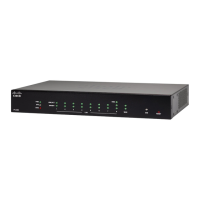CHAPTER 8
Routing
Routing is the process of selecting the best paths in a network. Dynamic routing is a networking technique
that provides optimal data routing. Dynamic routing enables routers to select paths according to real-time
logical network layout changes. The routing protocol operating on the router is responsible for the creation,
maintenance, and updating of the dynamic routing table in the dynamic routing.
This section describes the device's routing features and contains the following topics:
• Static Routing, on page 73
• RIP, on page 74
• IGMP Proxy, on page 75
Static Routing
Static Routing is a manually configured fixed pathway that a packet must travel to reach a destination. If there
is no communication between the routers on the current network topology, static routing can be configured
to communicate between the routers. Static Routing uses less network resources than dynamic routing because
they do not constantly calculate the next route to take.
To configure static routing, follow these steps:
Step 1 Select Routing > Static Routing.
Step 2 For IPv4 Routes, under the WAN Table, click Add and specify the following. You can edit an existing route by checking
its check box and clicking Edit.
Enter the destination subnetwork IP address to which you want to assign a static route
to.
Network
Enter the subnet mask of the destination address.Mask
Enter the IP address of the router of the last resort.Next Hop
Enter the hop count number (Max 255).Hop Count
Choose the interface to use for this static route from the drop-down list.Interface
Step 3 For IPv6 Routes, under the WAN Table, click Add and specify the following. You can edit an existing route by checking
its check box and clicking Edit.
RV260x Administration Guide
73

